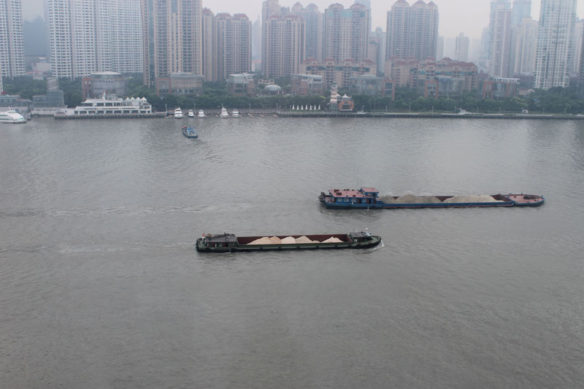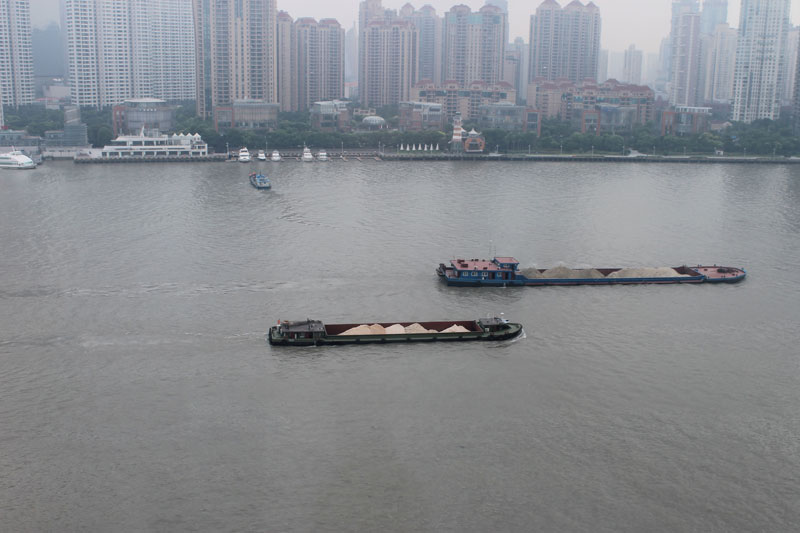
Sand barges. Photograph: © SAF — Coastal Care.
“Sand is the second most consumed natural resource, after water. The construction-building industry is by far the largest consumer of this finite resource. The traditional building of one average-sized house requires 200 tons of sand; a hospital requires 3,000 tons of sand; each kilometer of highway built requires 30,000 tons of sand… A nuclear plant, a staggering 12 million tons of sand…”—Denis Delestrac-©2013, “Sand Wars” Award-Winning Filmmaker.
Excerpts;
The island off the southern tip of Malaysia reveals the future of building in an epoch of dwindling territory…
Read Full Article, The New York Times (04-20-2017)
Built on Sand: Singapore and the New State of Risk, Harvard Design Magazine (09-07-2015)
The island’s expansion has been a colossal undertaking. It is not merely a matter of coastal reclamation: Singapore is growing vertically as well as horizontally. This means that the nation’s market needs fine river sand—used for beaches and concrete—as well as coarse sea sand to create new ground…
Sand Storm: $750 Million Worth of The Material is Unaccounted For in Cambodia; RFA (11-02-2016)
Nearly 50 civil society organizations called for the Cambodian government to join some other Southeast Asian nations and ban or severely restrict exports of sand to Singapore after it was revealed that nearly $750 million worth of the building material has disappeared from the country.
How Sand Became One of Phnom Penh’s Hottest Commodities, Cambodia; Next City (09-08-2014)
Global Witness, Shifting Sands, Singapore
Shifting Sand: how Singapore’s demand for Cambodian sand threatens ecosystems and undermines good governance
The island’s expansion has been a colossal undertaking. It is not merely a matter of coastal reclamation: Singapore is growing vertically as well as horizontally. This means that the nation’s market needs fine river sand—used for beaches and concrete—as well as coarse sea sand to create new ground…
Singapore And Jurong Island Reclamation; (09-12-2012)
What Happens to a Coral Reef When an Island is Built on Top? the Washington Post (07-11-2015)
Seven such coral reefs are being turned into islands, with harbors and landing strips by the Chinese military, and it is destroying a rich ecological network. “It’s the worst thing that has happened to coral reefs in our lifetime…”
Such Quantities of Sand, The Economist (07-27-2015)
Asia’s mania for reclaiming land from the sea spawns mounting problems…
Preventing Ecocide in South China Sea; Guardian UK (07-20-2015)
Land reclamation in the South China Sea could be damaging irreplaceable reef ecosystems, threatening the food security of millions. It’s time for a treaty, says leading scientist…
How and why China is building islands in the South China Sea, NewsWeek (03-29-2017)
Sand, Rarer Than One Thinks: A UNEP report (GEA-March 2014)
Despite the colossal quantities of sand and gravel being used, our increasing dependence on them and the significant impact that their extraction has on the environment, this issue has been mostly ignored by policy makers and remains largely unknown by the general public.
In March 2014 The United Nations released its first Report about sand mining. “Sand Wars” film documentary by Denis Delestrac – first broadcasted on the european Arte Channel, May 28th, 2013, where it became the highest rated documentary for 2013 – expressly inspired the United Nations Environment Programme (UNEP) to publish this 2014-Global Environmental Alert.
Sand Wars, An Investigation Documentary, By Mutlti-Awards Winner Filmmaker Denis Delestrac (©-2013)
Sand is the second most consumed natural resource, after water. The construction-building industry is by far the largest consumer of this finite resource. Land reclamation, shoreline developments and road embankments are using massive amounts of sand as well.
As of 2011-2012, when investigative filmmaker Denis Delestrac and team, were first collecting and unveiling unpublished sand mining datas and information from the professionals involved, the Sand business was estimated to be a $70 billion industry, worldwide…!—Denis Delestrac (©-2013)









